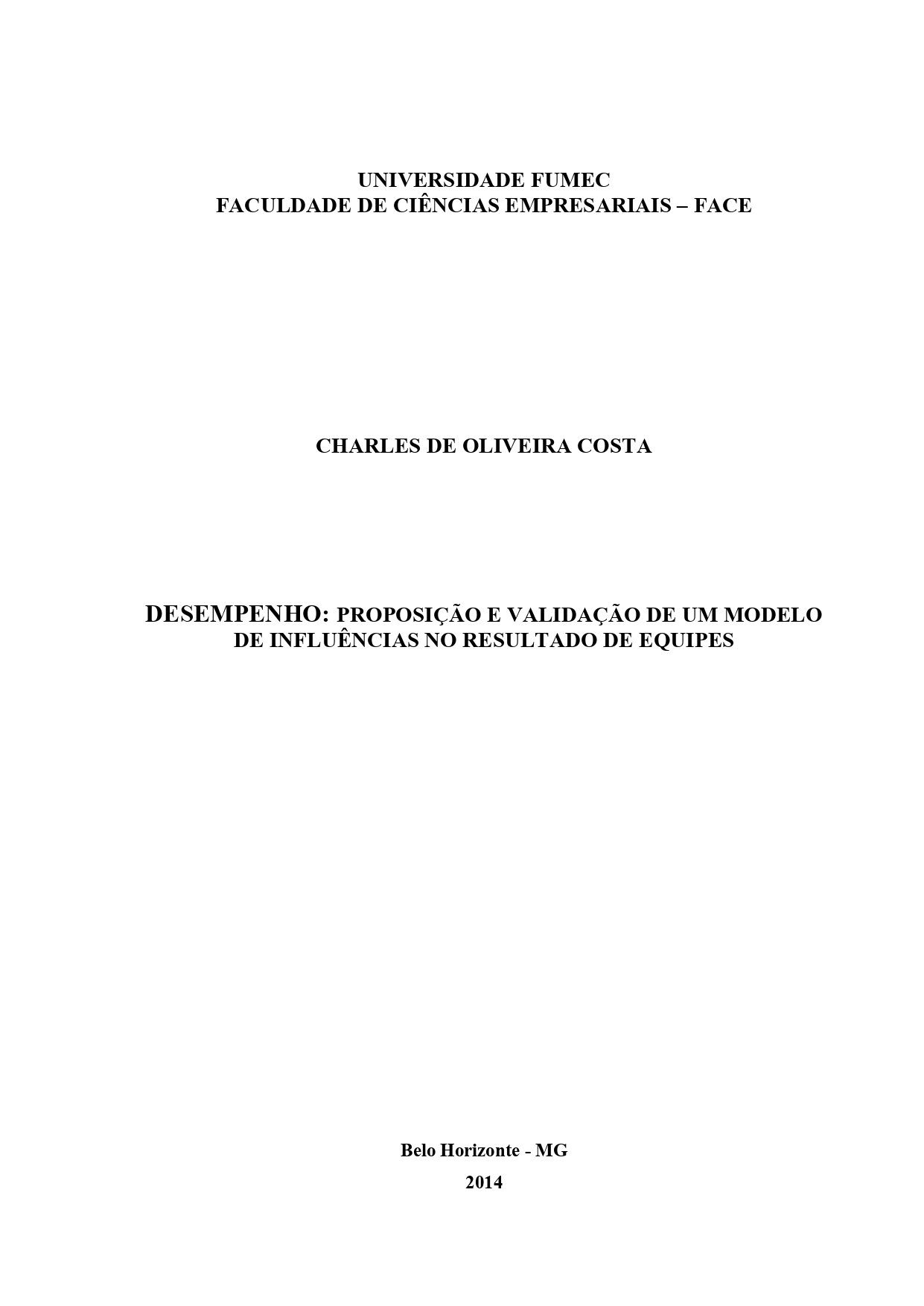Desempenho: proposição e validação de um modelo de influências no resultado de equipes

Visualizar/
Data
2014Autor
Costa, Charles de Oliveira
xmlui.mirage2.itemSummaryView.MetaData
Mostrar registro completoResumo
O desempenho das equipes nas organizações depende de muitos fatores e pode ser analisado conceitual ou empiricamente por diferentes modelos de pesquisa que buscam estudar o tema baseando-se em construtos específicos no âmbito do indivíduo, do grupo ou do ambiente. O objetivo geral desta dissertação foi analisar a influência dos mediadores Conflito, Comunicação, Potência, Autoeficácia e Interdependência na Coesão da equipe, e a influência da Coesão no Resultado da equipe. Metodologia: Para o alcance dos objetivos foi proposto um modelo teórico e o teste de hipóteses relacionadas a esse modelo. A pesquisa foi quantitativa, descritiva e de campo. A coleta de dados foi realizada por meio de um survey transversal utilizando um questionário criado para a pesquisa, contendo questões estruturadas em escala linear de 1 a 10, organizadas em grupo de questões de acordo com os constructos investigados. Para esta pesquisa obteve-se um total de 418 respondentes (145 policiais militares, 133 atletas de futebol e 140 funcionários do setor administrativo de uma empresa), com um total de 20.433 respostas para as 49 questões sobre o objeto de estudo. Para o tratamento estatístico, foi utilizado análise fatorial exploratória e confirmatória, dimensionalidade, confiabilidade, validade, métodos de equações estruturadas dentre outras. Resultados: O modelo estrutural possibilitou analisar e confirmar as hipóteses desse estudo, que considera os construtos investigados como mediadores e antecedentes da coesão, ou seja, as variáveis independentes (Comunicação, Conflito, Potência, Autoeficácia e Interdependência) influenciaram de forma significativa e positiva a variável dependente (Coesão). Dessa forma, quanto maior a comunicação, interdependência, conflito, potência e Autoeficácia, maior tende a ser a coesão da equipe. Estes construtos foram capazes de explicar 76% da variabilidade da coesão. Os resultados obtidos nessa pesquisa evidenciaram também que a coesão influencia de forma significativa e positiva o resultado alcançado. Sendo assim, quanto maior a coesão, maior tende a ser o resultado obtido pela equipe. A Coesão foi capaz de explicar 23,1% da variabilidade do resultado da equipe. Em relação à análise Multigrupo, os resultados apontaram que os constructos interdependência e potência apresentaram uma influência significativa e positiva sobre a coesão em todos os grupos investigados. A Comunicação não apresentou influência sobre a coesão no grupo Esporte, enquanto o Conflito não influenciou a coesão no grupo Polícia Militar. A Autoeficácia não apresentou influência sobre a coesão em ambos os grupos, esporte e Polícia Militar.A Coesão apresentou uma influência significativa e positiva sobre o resultado em todos os grupos estudados. Após o agrupamento de acordo com a capacidade de trabalho (baseado nos constructos Coesão e Interdependência) verificou-se que o grupo do esporte foi altamente associado ao grupo de alta capacidade de trabalho em equipe, enquanto que a Polícia Militar, foi fortemente associada ao grupo de baixa capacidade de trabalho em equipe. Conclusão: os objetivos desta pesquisa foram alcançados evidenciando-se que há uma influência significativa e positiva dos mediadores: Comunicação, Conflito, Interdependência, Potência e Autoeficácia na Coesão da equipe; e há uma influência significativa e positiva na Coesão da equipe no Resultado da equipe. The performance of teams in organizations depends on many factors and can be analyzed by different conceptual or empirical research models that seek to study the subject based on specific constructs to the individual, group or environment. The overall objective of this thesis was to analyze the influence of mediators Conflict, Communication, Power, Self-efficacy and Interdependence on team Cohesion, and the influence of cohesion in the team result. Methodology: To achieve the goals proposed a theoretical model and hypothesis testing related to this model. The research was quantitative, descriptive and field. Data collection was performed using a cross-sectional survey using a questionnaire created for research, containing structured questions in linear scale 1-10, organized group of issues according to the investigated constructs. For this research we obtained a total of 418 respondents (145 military police, 133 soccer athletes and 140 employees in the administrative sector of a company), with a total of 20,433 responses to the 49 questions on the subject matter. For the statistical analysis, we used exploratory and confirmatory factor analysis, dimensionality, reliability, validity, equations structured methods among others. Results: The structural model allowed analyze and confirm the hypotheses of this study, which considers the constructs investigated as mediators and background of cohesion, ie, the independent variables (Communication, Conflict, Potency, Self-efficacy and Interdependence) influenced significantly and positively the dependent variable Cohesion). Thus, the higher the Communication, Interdependence, Conflict, Potency and Self-efficacy greater tend to be team Cohesion. These constructs were able to explain 76% of the variability of Cohesion. The results obtained in this study also showed that cohesion influences significantly and positively the result achieved. Thus, the higher the Cohesion, the greater will be the Result obtained by the team. The cohesion was able to explain 23.1% of the variability of the results of the team. Regarding the multi-group analysis results indicate that the constructs Interdependence and Potency had a significant and positive influence on Cohesion in all groups investigated. The Communication had no effect on Cohesion in sport group, while the conflict did not affect the Cohesion in the military police group. Self-efficacy showed no influence on cohesion in both groups, sport and military police. Cohesion showed a significant and positive influence on the results in all groups. After the grouping according "teamwork capacity" (based on constructs cohesion and interdependence) it was found that the sport group was highly associated with the group of high capacity of teamwork, while the Military Police, was strongly associated with the group low ability to work in team. Conclusion: the objectives were achieved demonstrating that there is a significant and positive influence of mediators: Communication, Conflict, Interdependence, Potency and Self-efficacy in team cohesion; and there is a significant and positive influence on team cohesion in the team result.
